Abstract
The studies were conducted on the natural waters of Georgia: Gortubani and Naminauri (Adigeni region), Danisparauli, Dandalo and Makhinjauri (Adjara region) which exhibit medicinal properties. The following water indicators were determined: titratable acidity, electrical conductivity, hardness, the content of solids, sulfates, chlorides, hydrocarbonates, nitrates, ammonium salts and metals. These indicators were determined in the source water, as well as in the concentrate and permeate obtained by ultrafiltration. The productivity of the ultrafiltration process was determined, its dependence on the duration of the process, the applied pressure and the location of the spring. The productivity of the Danisparauli water ultrafiltration process decreases with time; the productivity remains unchanged during the filtration of the Makhinjauri and Naminauri waters; during ultrafiltration, the titratable acidity of the Makhinjauri water increases significantly, by 66.5%, that of the water Naminauri by 36.6%, the titratable acidity of the Danisparauli water remains unchanged, the sulfide ion content in the Makhinjauri water increases by 12%, and in the Naminauri water by 35.5%, the chloride content in the process of concentrating practically does not change. It was found that all the investigated waters are contaminated with heavy metals and the population should not use them for treatment. The data obtained can be used to simulate the purification of natural sources.
1. Introduction
The sustainable development of each country determines the quality of human life and health, which depends on the level of economic development [,], the state of the environment [,,,,,,,], the quality of food and drinking water [,,].
Mineral waters are mineralized subterranean or surface waters which have specific physicochemical properties (temperature, radioactivity, etc.), are enriched with biologically active substances and have medicinal qualities. Water is medicinal (healing) if one liter of water contains at least 1 g of mineral substances, and treatment with such water is called balneotherapy. Water must be highly potent or have a high temperature [,,].
The physical and chemical properties of water include temperature, mineralization, ionic composition, dissolved gases, radioactivity, biologically active compounds and trace elements [,].
By temperature, mineral waters are classified as follows: very cold (up to 4 °C); cold (4–20 °C); warm (hypothermal) (20–37 °C); hot (mesothermal) (37–42 °C); very hot (hyperthermal) (>42 °C).
It was found that medicinal waters, when passing deep into the soil, dissolve its salts and get enriched with them, especially in those cases when the water is retained for some reason and becomes motionless [,,].
Mineralization of water is determined by the content of the total amount of dissolved mineral substances. The following water groups are distinguished by mineralization: very low mineral content water (light mineral water) (2 g/L); low mineral content water (2–5 g/L); medium mineral content water (5–15 g/L); rich mineral content water (15–30 g/L); saturated (30–150 g/L); oversaturated (>150 g/L) [,,].
Very low mineral content water and high-calcium water has diuretic properties, and this contributes to the removal of bacteria, mucus, sand and small stones from the body along with urine. According to the content of excess salts, mineral waters are divided into hydrocarbonate, chloride, sulphate; combination of hydrocarbonate, chloride and sulfate waters—medicinal waters that contain biologically important ions, such as iron or arsenic [,,].
Gas containing mineral waters contain gases in a dissolved or free state. If the water contains carbon dioxide or hydrogen sulfide, it refers to a healing water for a specific purpose. Water may also contain nitrogen, methane and other gases, but currently such waters are underexplored and not fully understood. Mineral water may contain comparatively large amounts of the decay products of radioactive substances, such as radon and helium, and radioactive metals: uranium, thorium, and actinium []. If the content of radon and helium is more than 1/10 of the volume of water, then the water becomes industrially significant [,,].
On the territory of Georgia, more than two thousand springs have been discovered, including more than 730 springs of mineral waters, the daily volume of which is 130 million liters, of which a quarter is used for balneological purposes, more than half is used in heat supply and industrial bottling. Famous mineral healing waters include:
- ➢
- Borjomi—Medicinal-table hydrocarbonate sodium mineral water of medium mineralization. The springs are in the Borjomi Gorge, in eastern Georgia. Unlike many other similar mineral waters, Borjomi does not have time to cool underground and comes to the surface warm (38–41 °C), the water “undergoes” natural filtration and is enriched with 60 different minerals, which make its composition unique. The mineral water treats the digestive system, diseases of the gastrointestinal tract, biliary ducts, kidneys and much more [,,,,].
- ➢
- Likani—A unique natural medicinal-table water, saturated with minerals, contains a mineral-ion complex—a combination of magnesium and calcium hydrocarbonates. Likani is richly saturated with natural gas, therefore it perfectly quenches thirst. Carbon dioxide helps lift mineral water from a depth of 1500 m and gives it a light taste. The water springs are located in the Borjomi Valley at an altitude of 810 m above sea level.
- ➢
- Nabeglavi—Healing-table, carbonate–hydrocarbonate, sodium–calcium sparkling water. The spring is located at an altitude of 475 m above sea level. By its healing properties it is not inferior to the famous Borjomi mineral water—it is recommended both for balneology and drinking, regular use as table water helps to cleanse the body of harmful substances and enrich it with essential minerals. The increased content of magnesium ion has a beneficial effect on the cardiovascular and nervous systems. A small chlorine content significantly increases the therapeutic effect of water, and an increased number of sulfates is important for the treatment of diseases of the gastrointestinal tract. Due to the unique complex of minerals that make up Nabeglavi, the mineral water acts as an “inside shower” and perfectly cleanses the body. In addition, it enhances the immune system and is effective in the prevention and treatment of diseases of the digestive system and metabolism, also contributing to the removal of waste [].
- ➢
- Sairme—Natural table, healing-table and healing mineral waters which are formed in the deep zones of the earth’s crust, where they are saturated with natural carbon dioxide and come to the surface in the form of natural ascending (nongravity) spring. They are located in the west of Georgia, at an altitude of 950 m above sea level. The springs come from several sources and differ from each other in chemical composition and healing properties.
- ➢
- Bakuriani—Natural very low mineral content water, saturated with mineral complexes, regulates the body’s water balance. Frequent use of this water activates the physiological state of a person. The springs are in the east of Georgia. This water is characterized by a minimal concentration of calcium, potassium, sodium and magnesium, and contains a small amount of fluorine and iodine ions. It is recommended for use in baby food, and, with its unique composition, it is the best for people leading an active lifestyle [].
- ➢
- Healing water Lugela is unique not only in Georgia, but throughout the world. This is calcium chloride 9% mineral water and is transparent and odorless with a slightly bitter taste, which does not freeze even at the lowest possible temperature. The springs of the Lugela mineral waters are located in Western Georgia. It is a healing calcium chloride water that treats diseases of the skeletal system and joints, allergies, nephritis, stomatitis and bleeding [,,].
- ➢
- Mineral water Zvare is rich in iodine. It is used to treat the digestive system, chronic gastritis, pancreatitis, liver and biliary tract diseases, metabolic disorders and to balance acidity. The springs are located in Imereti (Western Georgia), at an altitude of 800 m above sea level.
- ➢
- Living water—This is the name of the thermal radon mineral waters of Tskhaltubo located at an altitude of 100 m above sea level. Biologically active trace elements were found in the mineral springs—iodine, bromine, manganese, lithium, boron, zinc, strontium, copper—which play an important role in the life of the body. The physical and chemical properties of water are unique: it is warm (35 °C), light, clean and odorless. The mineral springs were mainly used for bathing and inhalation, but in recent years natural radon waters have been increasingly used for drinking treatment. Radon therapy is used for diseases of the cardiovascular system, musculoskeletal system, digestive organs, central and peripheral nervous systems, skin diseases, metabolic disorders [].
- ➢
- Mitarbi mineral water springs are located in the gorge of the river Mitarbwater. The mineral water is used to treat chronic gastritis, chronic colitis, stomach ulcer and duodenal ulcer, chronic diseases of the biliary and urinary tract, metabolic disorders, chronic pancreatitis [,].
- ➢
- Bahmaro is fresh water with a very low salinity, the chemical composition of which is dominated by magnesium and calcium hydrocarbonates, it is saturated with oxygen and has an unusually mild taste. The water is approved and recommended for use in baby food [].
- ➢
- Sno is natural underground water which is rich in all necessary elements. This clear and tasty water is generated on the southern slopes of the central part of the Greater Caucasus Mountain Range at an altitude of 1700 m above sea level [,].
Currently, only five brands of mineral water are produced on an industrial scale: Borjomi, Nabeglavi, Sairme, Likani, and Bakuriani [,,,,]. However, despite the existence of such an abundance of produced and used mineral waters, the population spontaneously uses unofficial mineral springs with an unknown composition and unknown therapeutic properties to treat various types of diseases, which, naturally, poses a great threat to human health. The unauthorized use of mineral water causes massive poisoning and allergic reactions.
The objective of the work is to identify the chemical composition and physicochemical properties of natural and ultrafiltered mineral waters which are most often used by the population for drinking and for curative purposes.
2. Materials and Methods
The studies were conducted on the natural waters of Georgia—Gortubani and Naminauri (Adigeni region), Danisparauli, Dandalo and Makhinjauri (Adjara)—which exhibit medicinal properties: Sulfur-containing waters—Dandalo, Makhinjauri—treatment of fungal diseases (mycoses); Gortubani, Naminauri, Danisparauli—treatment of joints and diseases of the stomach.
The following water indicators were determined: titratable acidity (titrametric method), hardness (trilonometric method), solids content (refractometric method), sulfates (HACH-Method 8051), chlorides (argentometric method), hydrocarbonates (titrametric method), nitrates (HACH—Method LCK 339), ammonium salts (HACH—Method LCK 304) and metals (flame atomic emission spectrophotometer ICPE-9820), pH (ISO 10523: 2008) and electrical conductivity (conductometric method). These indicators were determined in the source water of the spring, as well as in the concentrate and permeate obtained as a result of ultrafiltration. The productivity of the ultrafiltration process was determined, its dependence on the duration of the process, the applied pressure and the location of the spring. The ultrafiltration was carried out in a tangential dynamic mode, on the UPL-06 installation, polyamide hollow fibers with an area of 2 m2 were used as membranes in the form of an AP-2.0 separation apparatus (produced in Kirishi, St. Petersburg).
The pore size of membranes is −500 Å and the mechanical stability limit of membranes is determined by the working pressure; for hollow fibers it is 1.8–2.0 MPa. The performance of the ultrafiltration process was calculated by the volume of permeate obtained from 1 m2 of the membrane per hour.
The structure of hollow fibers, the ultrafiltration processes conducted in it and the mechanism are shown on the Figure 1, Figure 2, Figure 3 and Figure 4.
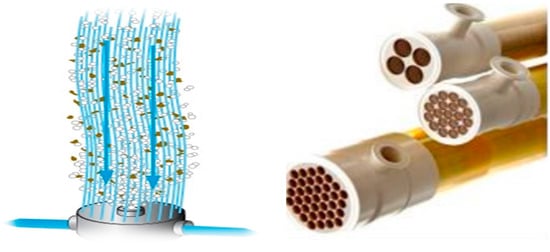
Figure 1.
Hollow fibers VPU-15PA.
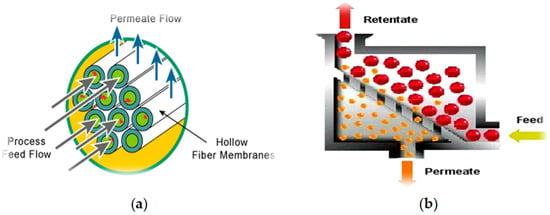
Figure 2.
The mechanism of the ultrafiltration: (a) Hollow fibers ultrafiltration mechanism, (b) Fractional separation during ultrafiltration.
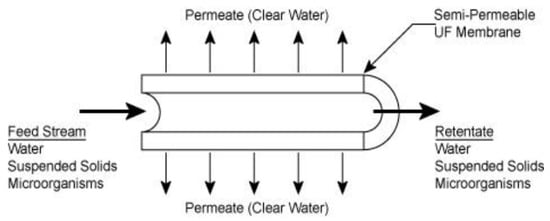
Figure 3.
The scheme of ultrafiltration process.
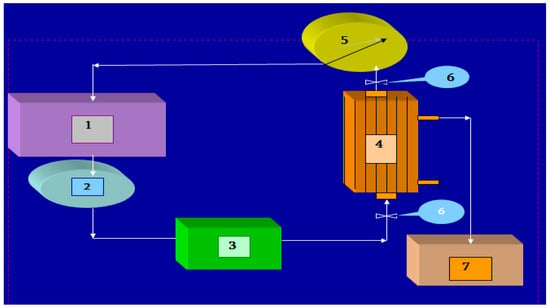
Figure 4.
Technical scheme of ultrafiltration-dynamic mode: 1—pectin isolate volume, 2—pump, 3—mechanical filter, 4—membrane filter, 5—manometer, 6—tap, 7—filtrate volume.
3. Results and Discussion
Ultrafiltration of medicinal waters was carried out. The productivity of the process was determined, its dependence on the filtration time, the type of medicinal water source, the titratable acidity, the content of sulfide and chloride ions, heavy metals, and electrical conductivity were determined in the filtrate and concentrate. The parameters were determined according to the type of healing water, the source area and the parameters of ultrafiltration process.
Figure 5 shows the dependence of the productivity of the ultrafiltration process of the medicinal waters (Danisparauli, Makhinjauri, Naminauri) on the filtration time.
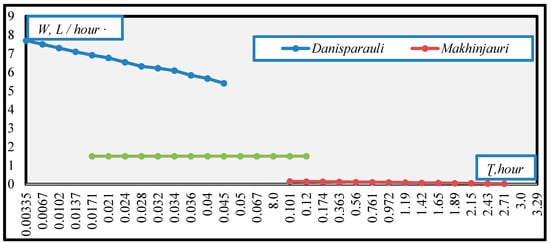
Figure 5.
The dependence of the productivity of the ultrafiltration process on time.
It was found that the productivity of the process of ultrafiltration of the Danisparauli water decreased over time and remained unchanged during filtration of the Makhinjauri and Naminauri waters. In permeate (filtrate) and concentrate, obtained as a result of filtration, a chemical analysis of the water was carried out. The titratable acidity data are presented in Figure 6.
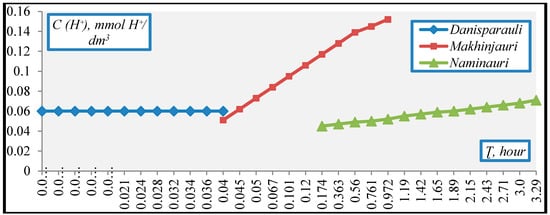
Figure 6.
Change in titratable acidity C(H+) of medicinal waters during ultrafiltration.
It was found that during ultrafiltration, the titratable acidity (CH+) of the Makhinjauri water increased significantly, by 66.5% (0.051–0.152 mmol/H+), of the Naminauri water—by 36.6% (0.045–0.071), while the titratable acidity of the Danisparauli water remained unchanged.
In sulfur-containing waters, the content of sulfide (S2−) ions was determined in the filtrate and concentrate (Figure 7).
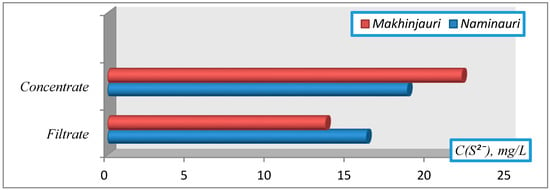
Figure 7.
Change in the content of sulfide ions during ultrafiltration of Naminauri and Makhinjauri mineral waters.
It was found that, in the process of concentrating, the content of sulfide (S2−) ions in the Naminauri water increases by 12%, and, in the Makhinjauri water, by 35.5%.
It has been established that the process of concentrating the Makhinjauri mineral water is more efficient than the Naminauri water. This result makes it possible to obtain and use the concentrate of the Makhinjauri mineral water, which is especially important in the treatment of fungal diseases with this water.
Chloride content was also determined in the filtrate and concentrate (Figure 8).
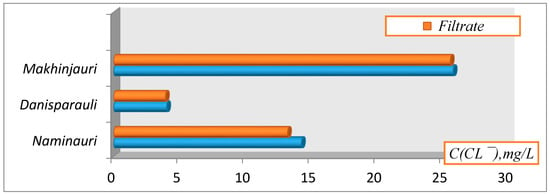
Figure 8.
Change in the content of chloride during ultrafiltration of Naminauri and Makhinjauri mineral waters.
It was found that the chloride content in the process of concentration is practically unchanged—that is, during the ultrafiltration process, chlorides are not retained by the filter hollow fibers and they completely pass into the concentrate. Hence it follows that the mineral composition of water in terms of chloride content does not change during ultrafiltration, which is very important, since it is the mineral composition that determines, overall, the healing effect of many waters.
To assess ecological cleanliness, the content of elements, mainly metals, was determined in medicinal waters (in total, 23 elements were determined): Cr, Fe, B, K, Ca, Mg, Na, Ba, Ti, Cd, Mo, Mn, Ni, Co, As, Sb, Pb, Si, Hg, V, Cu, Al, Zn (Figure 9, Figure 10, Figure 11, Figure 12, Figure 13, Figure 14, Figure 15 and Figure 16).
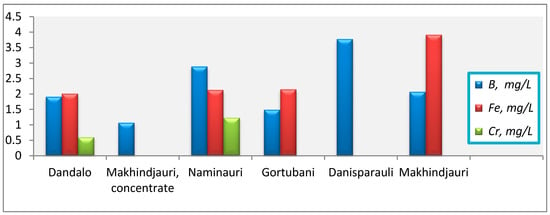
Figure 9.
The content of B, Fe and Cr in the Adjarian and Adigeni regions mineral waters.
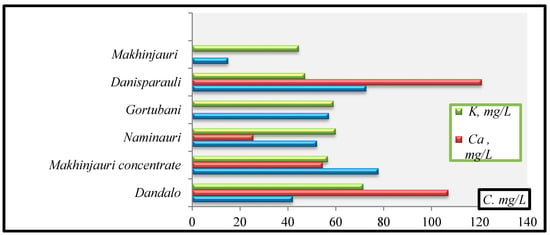
Figure 10.
The content of K, Ca and Mg in the mineral waters.
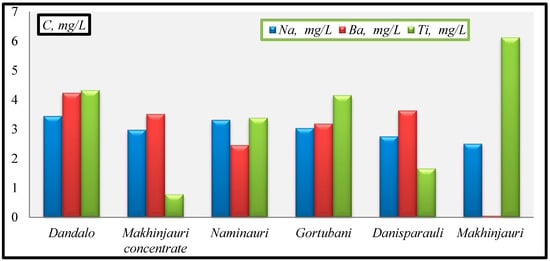
Figure 11.
The content of Na, Ba and Ti in the mineral waters.
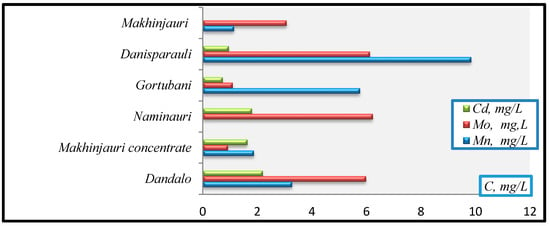
Figure 12.
The content of Cd, Mo and Mn in the mineral waters.
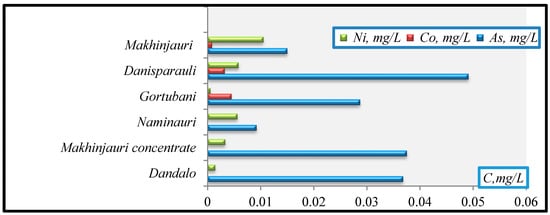
Figure 13.
The content of Co, Ni and As in the mineral waters.
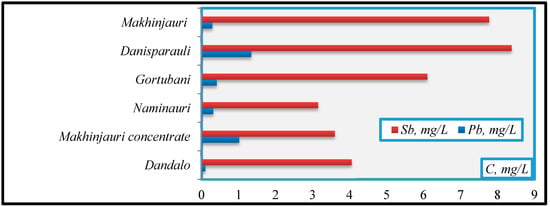
Figure 14.
The content of Sb and Pb in the mineral waters.
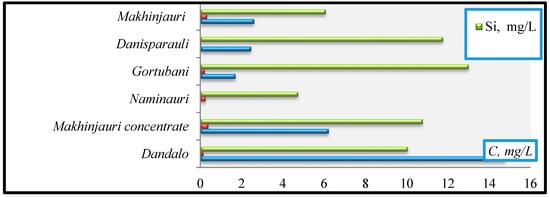
Figure 15.
The content of Si, Hg and V in the mineral waters.
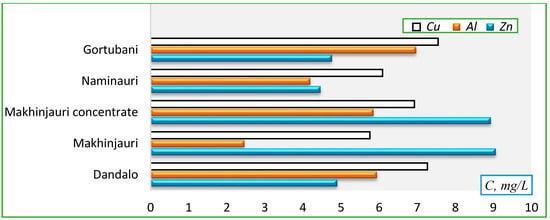
Figure 16.
The content of Zn, AL and Cu in the mineral l waters.
It is known that heavy metals have a negative effect on the human body, accumulate in it and ultimately cause blood disease—leukemia. On the one hand, a person taking mineral water facilitates the course of a specific disease, but on the other hand, he can get a blood disease
The data of the analysis of mineral waters for the content of metals, including heavy ones, are shown on Figure 9, Figure 10, Figure 11, Figure 12, Figure 13, Figure 14, Figure 15 and Figure 16.
Figure 9 presents data on the content of chromium, boron and iron in the mineral waters of Adjara, as well as, for comparison, data on the content of these metals in the waters of another region—Adigeni, Naminauri and Gortubani.
The obtained data on the content of metals in regions for comparison by region and between regions are presented in the form of series according to the principle of increasing:
- B (mg/L): Makhinjauri concentrate (1.07)→Gortubani (1.49)→Dandalo (1.91)→Makhinjauri (2.07)→Naminauri (2.89)→Danisparauli (3.78);
- Fe (mg/L): Dandalo (2.01)→Naminauri (2.13)→Gortubani (2.15)→Makhinjauri (3.92);
- Cr (mg/L): Dandalo (0.598)→Naminauri (1.23).
As can be seen from the data presented, the highest boron content is in Danisparauli water, iron in Dandalo water (Adjara region), and chromium in Naminayri water (Adigeni region). In the waters of Danisparauli and Makhinjauri concentrate, Fe was not found, Chromium was only found in the waters of Dandalo and Naminauri and all three elements were found in these two waters.
It should be especially noted that the content of these elements significantly exceeds the maximum allowable standards: Fe (norm 0.3) exceeded 7–13 times, Cr (norm 0.05) exceeded 10–12 times, B (norm 0.5) exceeded 2–12 times.
Figure 10 presents data on the content of K, Ca and Mg in the mineral waters.
- K(mg/L): Makhinjauri (44.5)→Danisparauli (47.1)→Makhinjauri concentrate (56.6)→Gortubani (59.0)→Naminauri (59)→Dandalo (71.4);
- Ca(mg/L): Naminauri (25.5)→Makhinjauri concentrate (54.5)→Dandalo (10.7)→Danisparauli(12.1);
- Mg(mg/L): Makhinjauri (42.0)→Naminauri (52.1)→Gortubani (57.1)→Danisparauli (72.7)→Makhinjauri concentrate (77.8).
As follows from the above, this magnesium content is overestimated in all waters, calcium is normal, and the potassium content normal in the waters of Adjara, Makhinjauri and Danisparauli, and is much higher in other waters. In the waters of Gortubani and Makhinjauri, Ca was not found, although Makhinjauri water is taken both for the treatment of fungal diseases and for the treatment of joints that need calcium.
Figure 11 presents data on the content of K, Ca and Mg in the mineral waters.
- Na(mg/L): Makhinjauri (2.51)→Danisparauli (2.76)→Makhinjauri concentrate (2.98)→Gortubani (3.04)→Naminauri (3.32)→Dandalo(3.45);
- Ba(mgL): Makhinjauri (0.0567)→Naminauri (2.46)→Gortubani (3.19)→Makhinjauri concentrate (3.52)→Danisparauli (3.64)→Dandalo.(4.24);
- Ti(mg/L): Makhinjauri concentrate (0.786)→Danisparauli (1.66)→Naminauri (3.39)→Gortubani (4.16)→Dandalo (4.33)→Makhinjauri (6.13).
It has been established that the sodium content in all waters is normal, while barium, only in Makhinjauri water, and titanium are significantly 7–61 times higher than the permissible norm.
The content of such heavy metals as Cd, Mo and Mn was also investigated in mineral waters. The data are presented in Figure 12 and in the form of comparison series.
- Cd(mg/L): Gortubani (0.72)→Danisparauli (0.944)→Makhinjauri concentrate (1.63→Naminauri (1.79)→Dandalo (2.19).
- Mo (mg/L): Makhinjauri concentrate (0.918)→Gortubani (1.09)→Makhinjauri (3.07)→Dandalo (5.98)→Danisparauli (6.12)→Naminauri (6.23).
- Mn (mg/L): Makhinjauri (1.14)→Makhinjauri concentrate (1.87)→Dandalo (3.27)→Gortubani (5.76)→Danisparauli (9.84).
As for the content of such elements as Cd, Mo and Mn, it significantly exceeds the permissible standards—Cd by 72–219, Mo by 4–24 and Mn by 10–32 times. Cadmium is not contained only in Makhinjauri water, but manganese in Naminauri water.
The Ni content was also studied with Co and As (Figure 13).
From the comparative series of data:
- Ni(mg/L): Gortubani (0.0005)→Dandalo (0.0014)→Makhinjauri concentrate(0.0033)→Naminauri (0.0056)→Danisparauli (0.0058)→Makhinjauri (0.0105);
- Co (mg/L): Makhinjauri (0.0008)→Danisparauli (0.0032)→Gortubani (0.0045), Dandalo.
- As(mg/L): Naminauri (0.0092)→Makhinjauri (0.015)→Gortubani (0.0287)→Dandalo (0.036)→Makhinjauri concentrate (0.0375)→Danisparauli (0.0491).
It was established that the content of these elements is below the permissible standards. In the waters of Naminauri and Makhinjauri concentrate, Co was not found.
In mineral waters, it has been established that the content of antimony is increased by 3–44 times, of lead 60–167 times (Figure 14), and their content is highest in the water of Danisparauli. As for other elements, the content of silicon is practically normal, mercury is 50–75 times higher than normal, and vanadium is 17–148 times higher (Figure 15).
- Sb (mg/L): Naminauri (3.15)→Makhinjauri concentrate (3.6)→Dandalo (4.06)→Gortubani (6.1)→Makhinjauri (7.77)→Danisparauli (8.38);
- Pb(mg/L): Dandalo(0.096)→Naminauri(0.317)→Gortubani(0.412)→Makhinjauri(0.298)→Makhinjauri concentrate (1.02)→Danisparauli (1.34).
- Si (mg/L): Naminauri (4.73)→Makhinjauri (6.07)→Dandalo (10.05)→Makhinjauri concentrate (10.77)→Danisparauli (11.75)→Gortubani (13).
- Hg (mg/L): Danisparauli (0.0267)→Dandalo (0.132)→Gortubani (0.208)→Naminauri (0.243)→Makhinjauri (0.315)→Makhinjauri concentrate (0.376).
- V(mg/L): Gortubani (1.7)→Danisparauli (2.45)→Makhinjaur (2.6)→Makhinjauri concentrate (6.21)→Dandalo (14.8). In the water of Naminauri were not found.
From the given comparative series of data, it follows that, in relation to mercury and vanadium, Makhinjauri water, which is very often used in the form of sulfur baths, is unfavorable.
- Zn (mg/L): Naminauri (4.46)→Gortubani (4.76)→Dandalo (4.9)→Danisparauli (8.65)→Makhinjauri concentrate (8.93)→Makhinjauri (9.06).
- Al (mg/L): Makhinjauri (2.46)→Naminauri (4.19)→Dandalo (5.65)→Makhinjauri concentrate (5.85)→Gortubani (6.97)→Danisparauli (8.16).
- Cu(mg/L): Makhinjauri (5.76)→Naminauri (6.09)→Makhinjauri concentrate (9.93)→Danisparauli (7.02)→Dandalo (7.27)→Gortubani (7.55).
As for zinc, aluminum and copper, the content of these elements is increased: zinc 45–90 times, aluminum 5–20 times, and copper 6–8 times higher than normal.
4. Conclusions
The studies were conducted on the natural waters of Georgia: Gortubani and Naminauri (Adigeni region), Danisparauli, Dandalo and Makhinjauri (Adjara region) which exhibit medicinal properties.
The following water indicators were determined: titratable acidity, electrical conductivity, hardness, the content of solids, sulfates, chlorides, hydrocarbonates, nitrates, ammonium salts and metals.
These indicators were determined in the source water, as well as in the concentrate and permeate obtained by ultrafiltration. The productivity of the ultrafiltration process was determined, its dependence on the duration of the process, the applied pressure and the location of the spring. The productivity of the Danisparauli water ultrafiltration process decreased with time, the productivity remained unchanged during the filtration of the Makhinjauri and Naminauri waters; during ultrafiltration, the titratable acidity (CH+) of the Makhinjauri water increased significantly, by 66.5% (0.051–0.152 mmol/L H+)—that of the Naminauri water by 36.6% (0.045–0.071)—the titratable acidity of the Danisparauli water remained unchanged, the sulfide ion content in the Makhinjauri water increased by 12%, and in the Naminauri water by 35.5%, the chloride content in the process of concentrating practically did not change.
It was found that all the investigated waters are contaminated with heavy metals and the population should not use them for treatment. It is necessary to conduct explanatory conversations with the population about the impossibility of using the water of these sources for drinking and for medicinal purposes.
These natural sources should be used only after preliminary purification of water from impurities and heavy metals using membrane technology; in particular, the use of electrodialysis with ion exchange membranes or ultrafiltration, or a combination of these methods.
It is necessary to carry out full monitoring of water: chemical and microbiological control, to familiarize the population with the monitoring results. In the case of negative results, it is important to temporarily close the sources and establish sources of pollution with heavy metals.
The data obtained can be used to create computer programs for predicting the purity of natural sources.
Author Contributions
Conceptualization, I.B. and T.K.; methodology, I.B. and T.K.; software, I.B.; validation, I.B., T.K. and V.P.; formal analysis, N.D. (Nato Didmanidze) and V.P; investigation, N.D. (Nazi Davitadze) and N.D. (Nato Didmanidze); resources, I.B.; data curation, I.B., and N.D. (Nato Didmanidze); writing—original draft preparation, I.B. and T.K.; writing—review and editing, I.B., T.K., and O.P.; visualization, N.D. (Nazi Davitadze); supervision, V.P.; project administration, O.P. All authors have read and agreed to the published version of the manuscript.
Funding
This research received no external funding.
Conflicts of Interest
The authors declare no conflict of interest.
References
- Prokopenko, O.; Eremenko, Y.; Omelyanenko, V. Role of international factor in innovation ecosystem formation. Econ. Ann. XXI 2014, 3–4, 4–7. [Google Scholar]
- Prokopenko, O.; Kysly, V.; Shevchenko, H. Peculiarities of the natural resources economic estimation under the transformational conditions. Econ. Ann. XXI 2014, 7–8, 40–43. [Google Scholar]
- Ishchenko, V.; Pohrebennyk, V.; Borowik, B.; Falat, P.; Shaikhanova, A. Toxic substances in hazardous household waste. In Proceedings of the International Multidisciplinary Scientific GeoConference SGEM, Albena, Bulgaria, 2–8 July 2018; Volume 18, pp. 223–230. [Google Scholar]
- Mitryasova, O.; Pohrebennyk, V. Hydrochemical indicators of water system analysis as factors of the environmental quality state. In Sustainable Production: Novel Trends in Energy, Environment and Material Systems. Studies in Systems, Decision and Control; Królczyk, G., Wzorek, M., Król, A., Kochan, O., Su, J., Kacprzyk, J., Eds.; Springer: Cham, Switzerland, 2020; Volume 198, pp. 91–104. [Google Scholar]
- Mitryasova, O.; Pohrebennyk, V. Integrated environmental assessment of the surface waters pollution: Regional aspect. In Proceedings of the International Multidisciplinary Scientific GeoConference SGEM, Vienna, Austria, 27–29 November 2017; Volume 33, pp. 235–242. [Google Scholar]
- Pohrebennyk, V.; Petryk, A. The degree of pollution with heavy metals of fallow soils in rural administrative units of Psary and Płoki in Poland. In Proceedings of the 17th International Multidisciplinary Scientific GeoConference, SGEM, Albena, Bulgaria, 29 June–5 July 2017; Volume 17, pp. 967–974. [Google Scholar]
- Mitryasova, O.; Pohrebennyk, V.; Cygnar, M.; Sopilnyak, I. Environmental natural water quality assessment by method of correlation analysis. In Proceedings of the International Multidisciplinary Scientific GeoConference Surveying Geology and Mining Ecology Management, SGEM, Albena, Bulgaria, 30 June–6 July 2016; Volume 2, pp. 317–324. [Google Scholar]
- Cherniuk, V.V.; Ivaniv, V.V.; Bihun, I.V.; Wojtowicz, J.M. Coeffificient of flow rate of inlet cylindrical nozzles with lateral orthogonal Inflflow. In Proceedings of the CEE International Conference Current Issues of Civil and Environmental Engineering, Lviv–Košice–Rzeszów, Lviv, Ukraine, 11–13 September 2019; pp. 50–57. [Google Scholar] [CrossRef]
- Bosak, N.; Cherniuk, V.; Matlai, I.; Bihun, I. Studying the mutual interaction of hydraulic characteristics of water distributing pipelines and their spraying devices in the coolers at energy units. East. Eur. J. Enterp. Technol. 2019, 3, 23–29. [Google Scholar] [CrossRef] [Green Version]
- Mitryasova, O.; Pohrebennyk, V.; Kardasz, P.; Pohrebennyk, V.; Kardasz, P. Hydrochemical aspects of surface water quality assessment. In Proceedings of the 18th International Multidisciplinary Scientific Geoconference, SGEM, Albena, Bulgaria, 2–8 July 2018; Volume 18, pp. 513–520. [Google Scholar]
- Bejanidze, I.; Pohrebennyk, V.; Kharebava, T.; Koncelidze, Z.; Jun, S. Development of waste-free, eco-pure combined technology for fruit processing. In Proceedings of the International Multidisciplinary Scientific GeoConference SGEM, Albena, Bulgaria, 30 June–6 July 2019; Volume 19, pp. 173–180. [Google Scholar]
- Bejanidze, I.; Pohrebennyk, V.; Kharebava, T.; Koncelidze, L.; Sun, J. Correction of the chemical composition of the washing waters received as a result of h cation exchange of ionex change resin. In Proceedings of the International International Multidisciplinary Scientific GeoConference SGEM, Albena, Bulgaria, 30 June–6 July 2019; Volume 19, pp. 133–140.
- Bejanidze, I.; Kardash, P.; Pohrebennyk, V.; Kharebava, T.; Didmanidze, N. Influence of technological parameters of ultrafiltration process of vegetable juices on their quality. In Proceedings of the International Multidisciplinary Scientific GeoConference SGEM, Albena, Bulgaria, 30 June–6 July 2019; Volume 19, pp. 321–328. [Google Scholar]
- Bejanidze, I.; Tavdgiridze, G.; Kharebava, T. Microbiological estimation of electrodialistic process of obtain potable water. Eur. Sci. Rev. 2017, 7–8, 137–139. [Google Scholar]
- Crompton, T.R. Determination of Toxic Organic Chemicals in Natural Waters, Sediments and Soils. Determination and Analysis; Academic Press: Cambridge, MA, USA, 2019; p. 422. ISBN 9780128165300. [Google Scholar]
- Raimer, A.A. Characteristic of the composition of mineral water. New Sci. Exp. Tradit. Innov. 2016, 591-2, 23–25. (In Russia) [Google Scholar]
- Charis, M.; Galanakis, E.A. Sustainable Water and Wastewater Processing; Elsevier: Amsterdam, The Netherlands, 2010; p. 393. ISBN 978012816170. [Google Scholar]
- Prasad, M.N.V. Disinfection By-products in Drinking Water. Detection and Treatment; Butterworth-Heinemann: Oxford, UK, 2020; p. 490. ISBN 9780081029770. [Google Scholar]
- Crompton, T.R. Determination of Metals in Natural Waters, Sediments, and Soils; Elsevier Science: Amsterdam, The Netherlands, 2015; p. 318. ISBN 9780128026540. [Google Scholar]
- Pavlova, A.; Krylova, O.; Vasnetsova, O. Mineral waters as a pharmaceutical product. Russia. Pharmacy 2018, 4, 7–12. [Google Scholar]
- Romanova, O. Treatment Wthin Live and Dead Water; Minsk: Vector, Belarus, 2007. [Google Scholar]
- Feng, Y.; Chung, T.-S. Hollow Fiber Membranes. Fabrication and Applications; Elsevier: Amsterdam, The Netherlands, 2020; p. 412. ISBN 9780128218761. [Google Scholar]
- Lidin, A. Mineral Waters; Publishing House: Quezon, Philippines, 2009. [Google Scholar]
- Bejanidze, I.; Kharebava, T.; Davitadze, N.; Koncelidze, Z.; Koncelidze, L. Monograph: Purification of natural and wastewater by electromembrane methods; BSU: Bulacan, Philippines, 2019; p. 178. [Google Scholar]
- Mitache, M.M.; Neagu, L.C.; Carmen, M. Microbiological and chemical characterization of bottled water. Sci. Beverages 2019, 4, 209–226. [Google Scholar]
- Huertos, M.L. Ecology and Management of Inland Waters. A Californian Perspective with Global Applications; Elsevier: Amsterdam, The Netherlands, 2020; p. 554. ISBN 9780128142660. [Google Scholar]
- Bejanidze, I.; Kharebava, T.; Kekutia, L.; Davitadze, N. The reagent-free, eco-pure technology for purification of natural waters from heavy metals. In Proceedings of the Third International Conference of European Academy of Science, Bonn, Germany, 20–30 December 2018; pp. 79–81. [Google Scholar]
- Zainchkovskiy, A.; Kushnirenko, A. Market of mineral water in ukraine: problems of quality and safety. Scientific Works of NUFT 2018, 24, 120–129. [Google Scholar] [CrossRef]
- Quattrini, S.; Pampaloni, B.; Brandi, M.L. Natural mineral waters: Chemical characteristics and health effects. Clin. Cases Miner Bone Metab. 2016, 13, 173–180. [Google Scholar] [CrossRef]
- Ahmad, A.; Azam, T. Water purification technologies bottled and packaged water. Sci. Beverages 2019, 4, 83–120. [Google Scholar]
- Bacciottini, L.; Tanini, A.; Falchetti, A.; Masi, L.; Franceschelli, F.; Pampaloni, B.; Giorgi, G.; Brandi, M.L. Calcium bioavailability from a calcium-rich mineral water, with some observations on method. J. Clin. Gastroenterol. 2004, 38, 761–766. [Google Scholar] [CrossRef] [PubMed]
- Chau, N.D.; Tomaszewska, B. Bottled and packaged water. Sci. Beverages 2019, 4, 1–38. [Google Scholar]
- Bertoni, M.; Olivieri, F.; Manghetti, M.; Boccolini, E.; Bellomini, M.G.; Blandizzi, C.; Bonino, F.; del Tacca, M. Effects of a bicarbonate-alkaline mineral water on gastric functions and functional dyspepsia: A preclinical and clinical study. Pharmacol. Res. 2002, 46, 525–531. [Google Scholar] [CrossRef] [PubMed]
- Grumezescu, A. Water Purification; Academic Press: Cambridge, MA, USA, 2017; p. 772. ISBN 9780128043004. [Google Scholar]
- Schnug, E.; Hassoun, R.; Haneklaus, S. Contribution of mineral and tap water to the dietary intake of as, B, Ca, Ce, Cu, F, La, Li, Mo, Ni, P, Pb, Sr, U, and Zn by humans water purification technologies bottled and packaged water. Sci. Beverages 2019, 4, 241–276. [Google Scholar]
- Singh, R.; Hankins, N. Emerging Membrane Technology for Sustainable Water Treatment; Elsevier: Amsterdam, The Netherlands, 2016; p. 480. ISBN 9780444633125. [Google Scholar]
- Sparling, D. Wildlife, Fisheries, Forests and Parks. Natural Resource. Administration; Academic Press: Cambridge, MA, USA, 2014; p. 374. ISBN 9780124046474. [Google Scholar]
- Gupta, V.K.; Imran, A. Environmental Water: Advances in Treatment, Remediation and Recycling; Elsevier Science: Amsterdam, The Netherlands, 2012; p. 426. ISBN 9780444594037. [Google Scholar]
- World Health Organization. Guidelines for Drinking-Water Quality; World Health Organization: Geneva, Switzerland, 1997; pp. 5–7. [Google Scholar]
- Pavlova, A.; Krylova, O.; Vasnetsova, O. Classification of mineral waters. Russia. Pharmacy 2018, 1, 8–13. [Google Scholar]
- Bothe, G.; Coh, A.; Auinger, A. Efficacy and safety of a natural mineral water rich in magnesium and sulphate for bowel function: A double-blind, randomized, placebo-controlled study. Eur. J. Nutr. Springer Nat. 2015, 56, 491–499. [Google Scholar] [CrossRef] [Green Version]
- Karagülle, O.; Kleczka, T.; Vidal, C.; Candir, F.; Gundermann, G.; Külpmann, W.; Gehrke, A.; Gutenbrunner, C. Magnesium Absorption from Mineral Waters of Different Magnesium Content in Healthy Subjects; Complementary Medicine Research Karger AG: Basel, Switzerland, 2006; p. 13. ISSN 2504–2106. [Google Scholar]
- Rylander, R.; Maurice, J. Mineral water intake reduces blood pressure among subjects with low urinary magnesium and calcium levels. BMC Public Health Springer Nat. 2004, 56, 1–5. [Google Scholar] [CrossRef] [Green Version]
- Greupner, T.; Schneider, I.; Hahn, A. Calcium bioavailability from mineral waters with different mineralization in comparison to milk and a supplement. J. Am. Coll. Nutr. 2017, 36, 386–390. [Google Scholar] [CrossRef]
- Meunier, P.; Jenvrin, C.; Munoz, M.; Gueronnière, V.; Garnero, P.; Menz, M. Consumption of a high calcium mineral water lowers biochemical indices of bone remodeling in postmenopausal women with low calcium intake. Osteoporos. Int. 2005, 16, 1203–1209. [Google Scholar] [CrossRef]
- GOST R 54316-2011. National standard of the Russian Federation. Natural Mineral Drinking Waters; General technical conditions; National Standard of the Russian Federation: Moskva, Russia, 2011. [Google Scholar]
- Tvalchrelidze, A.; Silagadze, A. Freshwater mineral water of Georgia for Europe. Cauc. Glob. 2011, 5, 53–64. [Google Scholar]
- EU’s Drinking Water Standards. Lenntech: Water Treatment Solutions. Available online: http://www.lenntech.com/ applications/drinking/standards/eu-s-drinking-water-standards.htm (accessed on 17 September 2020).
- Tarkhan-Mouravi, I. Resorts of Georgia; Balneological Resort Publishing House: Tbilisi, Georgia, 2009; p. 83. [Google Scholar]
- Janelidze, A. Treatment by Sairme; Springs: Tbilisi, Georgia, 2006; p. 46. [Google Scholar]
- Petrova, N.G.; Alibaev, S.G.; Shupineva, A.V. The therapeutic properties of water. Beer Drink. 2013, 6, 60–61. [Google Scholar]
- Sekerina, I.N. Monitoring of borjomi deposit of carbon dioxide mineral water as the informational basis for the study and revaluation of reserves. Geoecol. Eng. Geol. Hydrogeol. Geocryol. 2019, 3, 83–89. [Google Scholar] [CrossRef] [Green Version]
© 2020 by the authors. Licensee MDPI, Basel, Switzerland. This article is an open access article distributed under the terms and conditions of the Creative Commons Attribution (CC BY) license (http://creativecommons.org/licenses/by/4.0/).